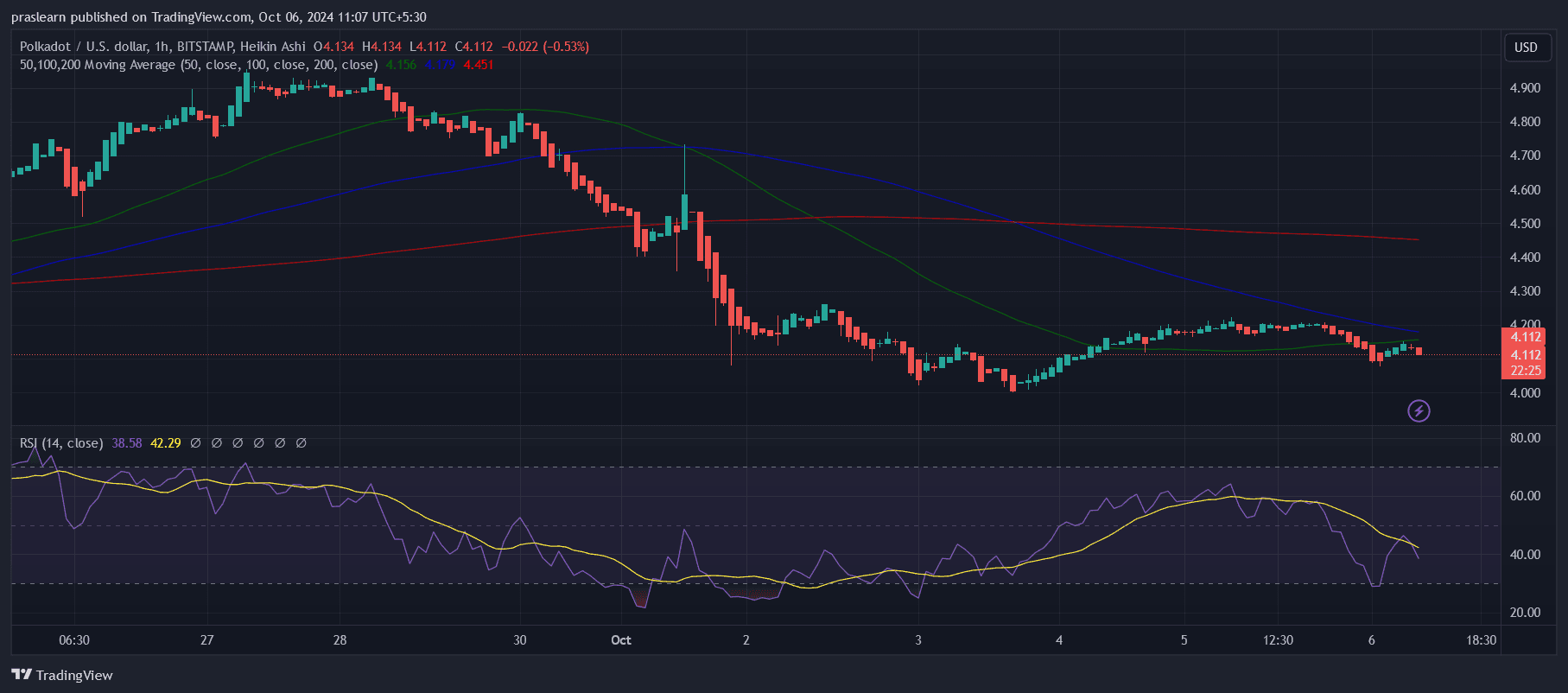Polkadot (DOT) has been facing a tough time in the market recently, struggling to move past a key resistance level. Investors are wondering whether this could mean a significant price drop, or if DOT will find the strength to rise again. In this Polkadot Price Prediction article, we’ll break down what’s happening with Polkadot's price, why it’s facing these challenges, and whether it could crash further or make a comeback soon.
How has the Polkadot (DOT) Price Moved Recently?

As of today, Polkadot (DOT) is priced at $4.12, with a 24-hour trading volume of $261.49 million, a market cap of $6.18 billion, and a market dominance of 0.29%. Over the past day, DOT's price has dipped by 1.87%.
Polkadot reached its all-time high of $54.98 on November 4, 2021. Its lowest recorded price was $2.82 on August 22, 2020. Since reaching its peak, the lowest DOT price observed was $3.59, and the highest rebound from this low was $11.86. Currently, the market sentiment for Polkadot is bearish, while the Fear & Greed Index stands at a neutral 50.
Polkadot has a circulating supply of 1.50 billion DOT, with a maximum supply of 1 billion DOT. The annual supply inflation rate is 51.85%, resulting in an additional 512.08 million DOT being created over the past year.
Why Polkadot (DOT) Price is Down?

The recent dip in Polkadot's (DOT) price can be attributed to several factors, both technical and market-driven. Despite an increase in on-chain activity, with over a 25% rise in active users since May 2023, the DOT price has faced challenges in maintaining momentum above key levels.
This rise in user engagement is generally a positive sign for network health and potential demand. However, the surge in activity has not directly translated into a stable price increase, indicating a disconnect between network usage and market sentiment.
DOT is currently oscillating between the $4 support level and the $5 resistance level. The inability to break past $5 suggests strong selling pressure, with sellers actively rejecting any attempts to push higher.
On the other hand, the support at $4 has proven resilient, as buyers have repeatedly stepped in to prevent a deeper fall. This price action reflects a tug-of-war between buyers and sellers, creating a narrow trading range. Should the $4 support be breached, the price is likely to fall to its multi-year support at $3.62, indicating a potential downward trend.
Predictively, the price movements of DOT are closely tied to these support and resistance zones. The stable volume increase in transactions hints at heightened market interest and activity, which may precede price shifts. If buyers can sustain pressure and push the price beyond the $5 resistance, DOT could see a strong upward movement.
However, if sellers regain control and break the $4 support, a deeper decline toward the $3.62 level is possible. The current neutral sentiment in the market suggests that external factors and broader market trends will play a significant role in determining whether DOT can break out of its current range or continue to face downward pressure. Overall, the price is likely to remain volatile in the near term as market forces struggle for dominance.
Polkadot Price Prediction: Will DOT Price Crash to 0?
Polkadot (DOT) is unlikely to crash to zero, given its current performance and market indicators. Over the past year, DOT has experienced a modest increase of 1%, outperforming its token sale price and showing stability in a highly volatile market. It has had 16 green days in the last 30 days, indicating a positive price movement for over half the month.
Moreover, the token exhibits high liquidity relative to its market cap, which adds a layer of stability as it facilitates easier buying and selling without significant price impact. This liquidity, along with DOT's outperformance compared to 74% of the top 100 crypto assets, suggests that the token is relatively resilient despite its challenges.
However, the price still faces several headwinds that contribute to its current struggle to rise significantly. DOT is down 92% from its all-time high, showing that it has had a significant correction since its peak. Additionally, the token is trading below its 200-day simple moving average, a generally bearish signal indicating a long-term downtrend.
The 51.85% yearly inflation rate is also a critical factor, as it means a large number of new DOT tokens are entering circulation, potentially diluting the price if demand does not keep up with supply. Furthermore, DOT has been outperformed by major cryptocurrencies like Bitcoin and Ethereum, which dominate the market and influence sentiment toward other altcoins like DOT.
From a predictive standpoint, DOT's price is unlikely to crash to zero, given its strong support levels, increased network activity, and positive movement compared to its token sale price. The token's ability to maintain its value above crucial support at $4 demonstrates underlying strength, and the active buying interest around this level acts as a safety net against a complete price collapse.
Moreover, the network's increased daily transaction volume and a growing number of active users signal a healthy ecosystem, which is crucial for long-term sustainability.
While the token's performance has lagged behind some of its peers, particularly Bitcoin and Ethereum, its current market behavior suggests that it will likely continue to oscillate within its established trading range rather than experience a dramatic crash to zero.
Should the market experience a significant downturn or DOT’s inflation rate lead to an oversupply without matching demand, the price could face downward pressure. However, as long as the token maintains liquidity and demand within its ecosystem, a complete collapse to zero is highly improbable. DOT's future trajectory will largely depend on its ability to break key resistance levels and maintain user engagement, while macroeconomic factors and the performance of the broader crypto market will play a pivotal role in shaping its price movement.
 cryptoticker.io
cryptoticker.io
